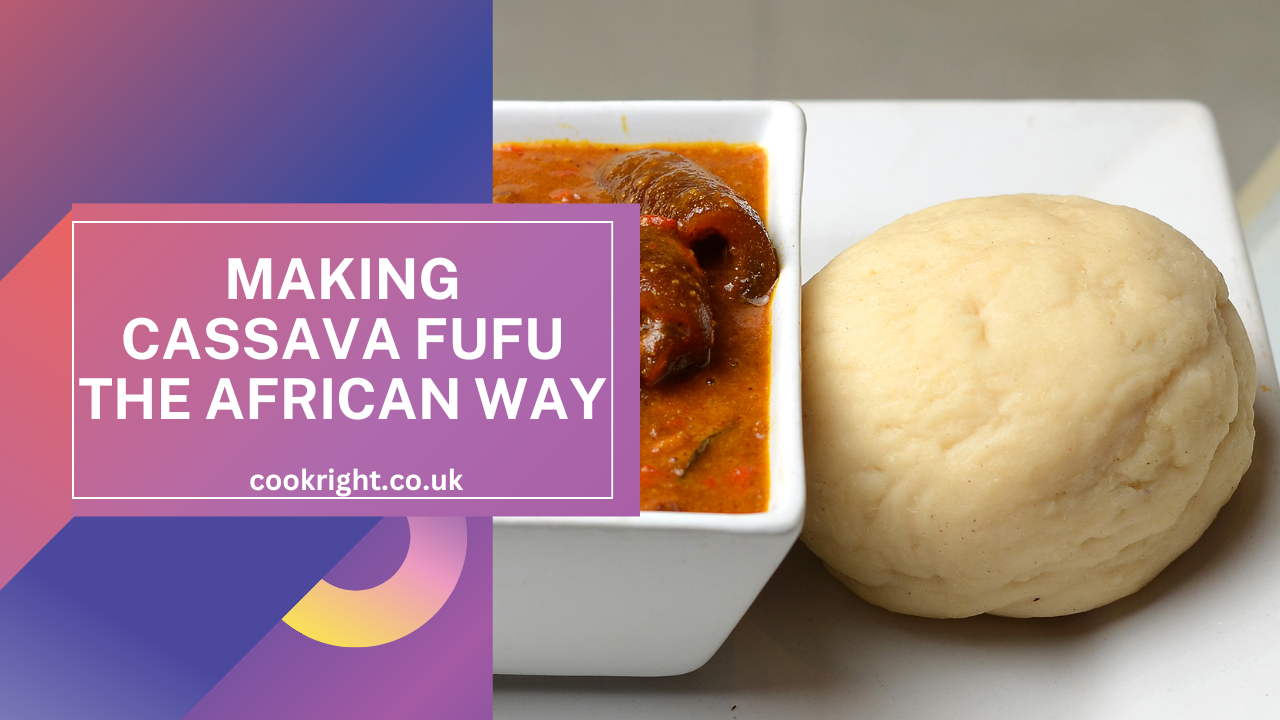Fufu, a staple food across many parts of West Africa, holds a cherished spot in the culinary traditions of countries like Ghana, Nigeria, and Ivory Coast. Made primarily from cassava, fufu’s appeal lies in its delightful texture and the way it perfectly complements rich, spicy stews and soups. Cassava, also known as yuca or manioc, is a versatile root vegetable that not only forms the basis of fufu but also serves as a crucial dietary element in tropical diets around the world due to its high carbohydrate content and adaptability.
In this blog post, we will explore the traditional method of making fufu from cassava, guiding you through the detailed process from selecting the right type of cassava to the final steps of cooking and serving. Whether you’re a seasoned lover of West African dishes or a curious culinary adventurer, this guide aims to equip you with all the knowledge you need to create this comforting dish in your own kitchen. Let’s dive into the world of fufu, where every step from the earthy aroma of boiling cassava to the rhythmic dance of the mortar and pestle contributes to creating a meal that’s as nourishing as it is culturally rich.
Ingredients and Tools Needed
Ingredients:
- Cassava: You will need about 2-4 pounds of fresh cassava, depending on how much fufu you want to make. Ensure the cassava is firm and free from blemishes.
- Water: Sufficient water to cover the cassava pieces for boiling.
Tools:
- Peeler: A sturdy vegetable peeler to remove the cassava skin.
- Knife: A sharp knife is crucial for cutting the cassava into manageable chunks.
- Large Pot: Needed for boiling the cassava until it is soft and ready to be pounded.
- Mortar and Pestle: Traditionally used to pound the boiled cassava into a smooth, elastic dough. If a mortar and pestle are not available, a heavy-duty food processor can be used as an alternative.
- Strainer or Colander: To drain the cassava after boiling.
- Wooden Spoon or Turner: Useful if you need to mash the cassava pieces slightly before pounding.
- Serving Bowl: To serve the fufu once it is ready.
By gathering these ingredients and tools before you begin, you’ll ensure a smooth and efficient process in making your fufu, keeping the traditional texture and taste intact.
Step-by-Step Instructions
1. Preparing the Cassava:
– **Selecting the Right Cassava**: Look for cassava that feels firm to the touch with no soft spots, bruises, or signs of blemishes. The skin should be intact without any cracks or excessive dryness. Freshness is key, as older cassava can develop a bitter taste.
– **Peeling and Washing the Cassava**: Use a sharp peeler or knife to carefully remove the thick outer skin of the cassava, which is not edible. Once peeled, cut the cassava into chunks and thoroughly wash them under running water to remove any dirt and potential toxins.
2. Cooking the Cassava:
- Boiling the Cassava: Place the cassava chunks in a large pot and cover them with water. Bring to a boil and then simmer for about 30 minutes or until the cassava is very soft and can be pierced easily with a fork.
- Alternative Cooking Methods: If boiling is not preferred, you can steam the cassava until it softens. Steaming helps retain more of the cassava’s natural flavor and nutrients compared to boiling.
3. Pounding the Cassava:
- Traditional Method Using a Mortar and Pestle: Transfer the soft cassava into a large mortar. Use the pestle to pound the cassava vigorously until it becomes smooth and stretchy, with no lumps. This process might take some effort and time but is crucial for achieving the authentic texture of fufu.
- Modern Alternatives Using Kitchen Appliances: As a more convenient option, a food processor or a high-powered blender can be used to mash the cassava. Pulse the boiled cassava until it achieves a dough-like consistency similar to that produced by traditional pounding.
4. Forming the Fufu:
- Techniques to Achieve the Right Texture and Consistency: The fufu should be elastic and smooth. If it feels too hard, you can add a small amount of the water used for boiling to adjust the consistency. Mix thoroughly to integrate any added water.
- Tips for Shaping and Serving: Wet your hands with water to prevent sticking and scoop the fufu into serving-sized balls. Serve immediately in a bowl alongside your favorite soup or stew. The warmth and softness of freshly made fufu enhance its ability to soak up delicious sauces.
Additional Tips and Tricks
- Consistency Check: After pounding or blending the cassava, ensure that the fufu is not too dry or too wet. Adjust the texture by adding small amounts of water if it’s too dry, or by continuing to pound or blend if it’s too wet, to achieve the perfect consistency.
- Avoid Lumps: To prevent lumps in your fufu, make sure the cassava is thoroughly cooked before you begin pounding or blending. Lumps usually form when the cassava isn’t soft enough.
- Prolong Freshness: If you make a large batch of fufu and have leftovers, it can be stored in the refrigerator for up to 3 days. To reheat, sprinkle a little water over the fufu and microwave it covered, or warm it in a steamer until it’s soft and heated through.
- Handling Stickiness: Fufu is naturally sticky, so regularly moisten your hands and utensils with water when handling it to prevent sticking. This will make it easier to form fufu balls and serve without a mess.
- Health Considerations: Cassava contains cyanogenic glycosides, which can release cyanide when eaten raw or improperly processed. Always cook cassava thoroughly to break down these compounds. Avoid using cassava that smells off or overly sour, as this can be a sign of spoilage or improper fermentation.
- Flavor Enhancements: For a slight twist, you can mix other root vegetables like yam or sweet potatoes with the cassava when making fufu. This not only adds different flavors but also varying textures to the fufu.
- Cultural Respect: When sharing or serving fufu, especially to those who may not be familiar with it, take a moment to share its cultural significance. This enhances the dining experience by connecting food with its cultural roots.
- Serving Suggestions: Traditionally, fufu is eaten with your hands by pinching off a small ball of it, making an indentation with your thumb, and using it to scoop up sauce or soup. Practice this technique to enjoy fufu authentically.
These tips and tricks will help you refine your fufu-making skills, ensuring that each batch comes out perfectly and is enjoyed to its fullest.
Serving and Pairing
How to Serve Fufu:
- Presentation: Serve fufu traditionally by forming it into smooth, round balls. Place these balls in a large, communal serving bowl or individual bowls depending on your setting and preference.
- Eating Etiquette: Fufu is typically eaten with the fingers. The proper way to eat it is to pinch off a small piece of fufu, roll it lightly into a ball, make a small indentation with your thumb, and use it to scoop up the sauce, soup, or stew it is served with.
- Temperature: Fufu should be served hot, as it enhances both its texture and its ability to blend with the flavors of the accompanying dishes.
Suggested Dishes to Pair with Fufu:
- Light Soups: Fufu goes well with light, brothy soups as it absorbs the flavors while maintaining its texture. Try pairing it with a tomato-based fish soup or a chicken broth enriched with herbs and spices.
- Rich Stews: Hearty and thick stews are traditional accompaniments for fufu. Popular options include West African peanut stew, palm nut soup, and egusi stew, which is made from melon seeds and typically contains leafy greens and meat or fish.
- Spicy Sauces: For those who enjoy heat, spicy sauces made with chili peppers, onions, and tomatoes are excellent. These robust flavors complement the mild taste of the fufu.
- Vegetarian Options: For a vegetarian or vegan meal, pair fufu with a stew made from mixed vegetables, coconut milk, and curry spices or with a rich mushroom and spinach stew.
Cultural Pairings:
- In Ghana, fufu is often served with groundnut soup, which has a creamy texture and a savory flavor profile.
- In Nigeria, it might be paired with ogbono soup, known for its unique, slippery texture that goes well with the softness of fufu.
- In Ivory Coast, light fish stews with plenty of herbs and spices make a frequent side for fufu.
Understanding these serving and pairing nuances will help you fully appreciate fufu’s role in a meal and enhance the overall dining experience for you and your guests. Whether enjoying it in a traditional setting or incorporating it into a more contemporary menu, fufu provides a delightful culinary journey through texture and taste.
Conclusion
Making fufu from cassava is a rewarding experience that connects you with a rich culinary tradition spanning across West Africa. The process, from selecting the right cassava to serving it alongside a flavorful stew or soup, is an art form that reflects the region’s culture and communal dining practices. Whether you’re a seasoned cook familiar with African cuisines or a curious food enthusiast looking to expand your culinary horizons, mastering the art of making fufu offers a unique insight into the importance of food in bringing people together.
We’ve walked through the essential steps of preparing, cooking, and serving fufu, along with some helpful tips to ensure your success. Remember, the key to perfect fufu lies in the texture and the joy of sharing it with others. I encourage you to embrace the process, experiment with different pairings, and enjoy the delicious results.
Feel free to leave comments with your experiences, any variations you tried, and how you chose to serve your fufu. Food is a journey, and every dish tells a story. Let fufu be your gateway to exploring the rich flavors and communal spirit of African cuisine. Happy cooking!



